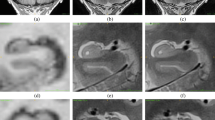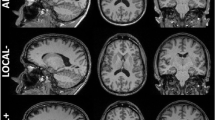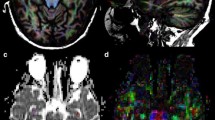Abstract
Purpose
The hippocampus has a critical role in many common disease processes. Currently, routine 3 Tesla structural MRI is a mainstay of clinical diagnosis. The goal of our study is to evaluate the normal variability in size and/or conspicuity of the hippocampal subcomponents in routine clinical 3 Tesla high-resolution T2-weighted images to provide a basis for better defining pathological derangements. Additionally, we utilize diffusion data acquired from a 17.6 Tesla MRI of the hippocampus as a benchmark to better illustrate these subcomponents.
Methods
The hippocampus was retrospectively assessed on 104 clinically normal patients undergoing coronal T2-weighted imaging. The conspicuity of the majority of hippocampal subcomponents was assessed in each portion of the hippocampus. Additionally, easily applicable cross-sectional measurements and signal intensities were obtained to evaluate the range of normal, as well as inter- and intra-subject variability.
Results
The normal range of cross-sectional measurements of the hippocampal subcomponents was calculated. There was minimal side-to-side variability in cross-sectional measurements of hippocampal subcomponents (< 5%) with the exception of the subiculum (R>L by 8.3%) and the CA4/DG (R>L by 5.8%). The internal architecture showed high variability in visibility of subcomponents between different segments of the hippocampus.
Conclusions
Confident clinical assessment of the hippocampus requires a thorough knowledge of hippocampal size and signal, but also the internal architecture expected to be seen. The data provided in this study will provide the reader with vital information necessary for distinguishing a normal from abnormal exam.




Similar content being viewed by others
References
Adachi M, Kawakatsu S, Hosoya T, Otani K, Honma T, Shibata A, Sugai Y (2003) Morphology of the inner structure of the hippocampal formation in Alzheimer disease. AJNR Am J Neuroradiol 24:1575–1581
Amaral DG, Kondo H, Lavenex P (2014) An analysis of entorhinal cortex projections to the dentate gyrus, hippocampus, and subiculum of the neonatal macaque monkey. J Comp Neurol 522:1485–1505. doi:10.1002/cne.23469
Bobinski M, de Leon MJ, Tarnawski M, Wegiel J, Reisberg B, Miller DC, Wisniewski HM (1998) Neuronal and volume loss in CA1 of the hippocampal formation uniquely predicts duration and severity of Alzheimer disease. Brain Res 805:267–269
Bote RP, Blázquez-Llorca L, Fernández-Gil MA, Alonso-Nanclares L, Muñoz A, de Felipe J (2008) Hippocampal sclerosis: histopathology substrate and magnetic resonance imaging. Semin Ultrasound CT MR 29:2–14
Briellmann RS, Syngeniotis A, Jackson GD (2001) Comparison of hippocampal volumetry at 1.5 T and at 3 T. Epilepsia 42:1021–1024
Chakeres DW, Whitaker CDS, Dashner RA, Scharre DW, Beversdorf DQ, Raychaudhury A, Schmalbrock P (2005) High-resolution 8 T imaging of the formalin-fixed normal human hippocampus. Clin Anat 18:88–91. doi:10.1002/ca.10232
Colon-Perez LM, King M, Parekh M, Boutzoukas A, Carmona E, Couret M, Klassen R, Mareci TH, Carney PR (2015) High-field magnetic resonance imaging of the human temporal lobe. NeuroImage Clin 9:58–68. doi:10.1016/j.nicl.2015.07.005
Coras R, Milesi G, Zucca I, Mastropietro A, Scotti A, Figini M, Mühlebner A, Hess A, Graf W, Tringali G, Blümcke I, Villani F, Didato G, Frassoni C, Spreafico R, Garbelli R (2014) 7 T MRI features in control human hippocampus and hippocampal sclerosis: an ex vivo study with histologic correlations. Epilepsia 55:2003–2016. doi:10.1111/epi.12828
Demeter S, Rosene DL, van Hoesen GW (1985) Interhemispheric pathways of the hippocampal formation, presubiculum, and entorhinal and posterior parahippocampal cortices in the rhesus monkey: the structure and organization of the hippocampal commissures. J Comp Neurol 233:30–47. doi:10.1002/cne.902330104
Ding S-L (2013) Comparative anatomy of the prosubiculum, subiculum, presubiculum, postsubiculum, and parasubiculum in human, monkey, and rodent. J Comp Neurol 521:4145–4162. doi:10.1002/cne.23416
Fatterpekar GM, Naidich TP, Delman BN, Aguinaldo JG, Gultekin SH, Sherwood CC, Hof PR, Drayer BP, Fayad ZA (2002) Cytoarchitecture of the human cerebral cortex: MR microscopy of excised specimens at 9.4 T. AJNR Am J Neuroradiol 23:1313–1321
Furshpan EJ, Potter DD (1989) Seizure-like activity and cellular damage in rat hippocampal neurons in cell culture. Neuron 3:199–207
Gilmore RL, Childress MD, Leonard C, Quisling R, Roper S, Eisenschenk S, Mahoney M (1995) Hippocampal volumetrics differentiate patients with temporal lobe epilepsy and extratemporal lobe epilepsy. Arch Neurol 52:819–824
Goldberg H, Weinstock A, Bergsland N, Dwyer MG, Farooq O, Sazgar M, Poloni G, Treu C, Weinstock-Guttman B, Ramanathan M, Zivadinov R (2014) MRI segmentation analysis in temporal lobe and idiopathic generalized epilepsy. BMC Neurol 14:131. doi:10.1186/1471-2377-14-131
Hanamiya M, Korogi Y, Kakeda S, Ohnari N, Kamada K, Moriya J, Sato T, Kitajima M, Akamatsu N, Tsuji S (2009) Partial loss of hippocampal striation in medial temporal lobe epilepsy: pilot evaluation with high-spatial-resolution T2-weighted MR imaging at 3.0 T. Radiology 251:873–881. doi:10.1148/radiol.2513080445
Hatanpaa KJ, Raisanen JM, Herndon E, Burns DK, Foong C, Habib AA, White CL (2014) Hippocampal sclerosis in dementia, epilepsy, and ischemic injury: differential vulnerability of hippocampal subfields. J Neuropathol Exp Neurol 73:136–142. doi:10.1097/OPX.0000000000000170
Insausti R, Juottonen K, Soininen H, Insausti AM, Partanen K, Vainio P, Laakso MP, Pitkänen A (1998) MR volumetric analysis of the human entorhinal, perirhinal, and temporopolar cortices. AJNR Am J Neuroradiol 19:659–671
Kasasbeh A, Hwang EC, Steger-May K, Bandt SK, Oberhelman A, Limbrick D, Miller-Thomas MM, Shimony JS, Smyth MD (2012) Association of magnetic resonance imaging identification of mesial temporal sclerosis with pathological diagnosis and surgical outcomes in children following epilepsy surgery. J Neurosurg Pediatr 9:552–561. doi:10.3171/2012.1.PEDS11447
Kitt CA, Mitchell SJ, DeLong MR, Wainer BH, Price DL (1987) Fiber pathways of basal forebrain cholinergic neurons in monkeys. Brain Res 406:192–206
Koliatsos VE, Martin LJ, Walker LC, Richardson RT, DeLong MR, Price DL (1988) Topographic, non-collateralized basal forebrain projections to amygdala, hippocampus, and anterior cingulate cortex in the rhesus monkey. Brain Res 463:133–139
Kosel KC, van Hoesen GW, Rosene DL (1982) Non-hippocampal cortical projections from the entorhinal cortex in the rat and rhesus monkey. Brain Res 244:201–213
Likeman M (2013) Imaging in epilepsy. Pract Neurol 13:210–218. doi:10.1136/practneurol-2012-000477
Lucarelli RT, Peshock RM, McColl R, Hulsey K, Ayers C, Whittemore AR, King KS (2013) MR imaging of hippocampal asymmetry at 3 T in a multiethnic, population-based sample: results from the Dallas Heart Study. AJNR Am J Neuroradiol 34:752–757. doi:10.3174/ajnr.A3308
Mumoli L, Labate A, Vasta R, Cherubini A, Ferlazzo E, Aguglia U, Quattrone A, Gambardella A (2013) Detection of hippocampal atrophy in patients with temporal lobe epilepsy: a 3-Tesla MRI shape. Epilepsy Behav EB 28:489–493. doi:10.1016/j.yebeh.2013.05.035
Pedraza O, Bowers D, Gilmore R (2004) Asymmetry of the hippocampus and amygdala in MRI volumetric measurements of normal adults. J Int Neuropsychol Soc JINS 10:664–678. doi:10.1017/S1355617704105080
Phal PM, Usmanov A, Nesbit GM, Anderson JC, Spencer D, Wang P, Helwig JA, Roberts C, Hamilton BE (2008) Qualitative comparison of 3-T and 1.5-T MRI in the evaluation of epilepsy. AJR Am J Roentgenol 191:890–895. doi:10.2214/AJR.07.3933
Pitkänen A, Nissinen J, Nairismägi J, Lukasiuk K, Gröhn OHJ, Miettinen R, Kauppinen R (2002) Progression of neuronal damage after status epilepticus and during spontaneous seizures in a rat model of temporal lobe epilepsy. Prog Brain Res 135:67–83. doi:10.1016/S0079-6123(02)35008-8
Sanchez JC, Mareci TH, Norman WM, Principe JC, Ditto WL, Carney PR (2006) Evolving into epilepsy: multiscale electrophysiological analysis and imaging in an animal model. Exp Neurol 198:31–47. doi:10.1016/j.expneurol.2005.10.031
Saunders RC, Aggleton JP (2007) Origin and topography of fibers contributing to the fornix in macaque monkeys. Hippocampus 17:396–411. doi:10.1002/hipo.20276
Strange BA, Witter MP, Lein ES, Moser EI (2014) Functional organization of the hippocampal longitudinal axis. Nat Rev Neurosci 15:655–669. doi:10.1038/nrn3785
Thomas BP, Welch EB, Niederhauser BD, Whetsell WO, Anderson AW, Gore JC, Avison MJ, Creasy JL (2008) High-resolution 7 T MRI of the human hippocampus in vivo. J Magn Reson Imaging JMRI 28:1266–1272. doi:10.1002/jmri.21576
van Paesschen W (2004) Qualitative and quantitative imaging of the hippocampus in mesial temporal lobe epilepsy with hippocampal sclerosis. Neuroimaging Clin N Am 14(3):373–400. doi:10.1016/j.nic.2004.04.004
Winterburn JL, Pruessner JC, Chavez S, Schira MM, Lobaugh NJ, Voineskos AN, Chakravarty MM (2013) A novel in vivo atlas of human hippocampal subfields using high-resolution 3 T magnetic resonance imaging. Neuroimage 74:254–265. doi:10.1016/j.neuroimage.2013.02.003
Wisse LEM, Gerritsen L, Zwanenburg JJM, Kuijf HJ, Luijten PR, Biessels GJ, Geerlings MI (2012) Subfields of the hippocampal formation at 7 T MRI: in vivo volumetric assessment. NeuroImage 61:1043–1049. doi:10.1016/j.neuroimage.2012.03.023
Witter MP (2007) The perforant path: projections from the entorhinal cortex to the dentate gyrus. Prog Brain Res 163:43–61. doi:10.1016/S0079-6123(07)63003-9
Witter MP, Amaral DG (1991) Entorhinal cortex of the monkey: V. Projections to the dentate gyrus, hippocampus, and subicular complex. J Comp Neurol 307:437–459. doi:10.1002/cne.903070308
Yassa MA, Muftuler LT, Stark CEL (2010) Ultrahigh-resolution microstructural diffusion tensor imaging reveals perforant path degradation in aged humans in vivo. Proc Natl Acad Sci USA 107:12687–12691. doi:10.1073/pnas.1002113107
Yukie M (2000) Connections between the medial temporal cortex and the CA1 subfield of the hippocampal formation in the Japanese monkey (Macaca fuscata). J Comp Neurol 423:282–298
Yushkevich PA, Avants BB, Pluta J, Das S, Minkoff D, Mechanic-Hamilton D, Glynn S, Pickup S, Liu W, Gee JC, Grossman M, Detre JA (2009) A high-resolution computational atlas of the human hippocampus from postmortem magnetic resonance imaging at 9.4 T. NeuroImage 44:385–398. doi:10.1016/j.neuroimage.2008.08.042
Yushkevich PA, Pluta JB, Wang H, Xie L, Ding SL, Gertje EC, Mancuso L, Kliot D, Das SR, Wolk DA (2015 Jan) Automated volumetry and regional thickness analysis of hippocampal subfields and medial temporal cortical structures in mild cognitive impairment. Hum Brain Mapp 36(1):258–287. doi:10.1002/hbm.22627
Author information
Authors and Affiliations
Corresponding author
Ethics declarations
Conflict of interest
The authors declare that they have no conflict of interest.
Rights and permissions
About this article
Cite this article
Middlebrooks, E.H., Quisling, R.G., King, M.A. et al. The hippocampus: detailed assessment of normative two-dimensional measurements, signal intensity, and subfield conspicuity on routine 3T T2-weighted sequences. Surg Radiol Anat 39, 1149–1159 (2017). https://doi.org/10.1007/s00276-017-1843-x
Received:
Accepted:
Published:
Issue Date:
DOI: https://doi.org/10.1007/s00276-017-1843-x




